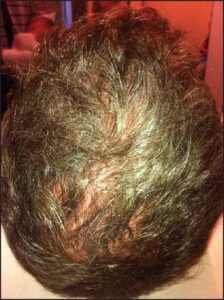With so many hair restoration products available, it’s easy to feel overwhelmed. Let’s cut through the noise and talk about the science. We’re focusing on a powerful combination: using PRP with stem cells for hair loss. Instead of just promises, we’ll show you the research and PRP for hair loss studies from leading institutes. Understanding how this works at a cellular level is the key to seeing real prp stem cell hair regrowth results. This dual-action approach can awaken dormant follicles and encourage substantial new growth, leading to the PRP results hair you’re looking for.
At the Darrow Stem Cell Institute we utilize Platelet Rich Plasma (PRP) not only to accelerate repair of damaged joints, but also for the regeneration of hair.
- PRP treatments involve collecting a small amount of your blood and spinning it in a centrifuge to separate the platelets from the red cells. The collected platelets are then injected into an area of thinning hair on the scalp. These treatments can then stimulate hair regeneration in many people. The treatment is aptly named Platelet Rich Plasma therapy as it is blood plasma that is rich is platelets. Now let’s find out how they work.
A June 2018 study in the Journal of cosmetic dermatology (1) reported these findings about PRP for hair loss and how it worked.
“The clinical application of platelet-rich plasma (PRP) is based on the increase in the concentration of growth factors that are released from (the) alpha-granule (simply the container within the blood that holds growth factors) of the concentrated platelets and in the secretion of proteins which are able to capitalize on the healing process at the cellular level. It has been invented to restore the natural beauty by starting the natural rejuvenation process of the skin and aiming to make it function as a younger one and to keep the skin youthful and maintain it. Besides that, it is also emerged to include hairs as a new injectable procedure to enable stimulating hair growth locally and topically; preventing its fall; improving hair shaft, hair stem, and its caliber; increasing its shine, vitality, and pliability; and declining hair splitting and breakage. Thus, youth is in your blood as it has a magical power imposed in the platelet factors.”
Now we do not like to use the word “magical” to describe any medical procedure because we want our patients to know their realistic options before treatment, but here is the word “magical” being used in a peer-reviewed and well esteemed medical journal. So there may be something to this PRP treatment for hair restoration.
Why Consider PRP for Hair Loss?
This is what doctors at university medical centers in Greece published their review of PRP’s effect on androgenetic alopecia and alopecia areata seem to suggest At the beginning of their paper, the Greek doctors answered the question posed above: why another hair loss treatment when there are so many to choose from?
Here is their answer:
“Despite available therapeutic options, the search for new, more effective hair restoration treatment is constant. Platelet-rich plasma could be the more effective treatment. . . Growth factors in platelets’ granules of PRP bind in the bulge area of hair follicle, promoting hair growth making PRP a potential useful therapeutic tool for alopecias, without major adverse effects.” (2)
The Greek doctors answered the question. Why PRP as a hair loss treatment? It works.
Here Dr. Darrow is injecting PRP into a patient’s scalp to regrow hair! Platelet-rich plasma (PRP) therapy stimulates hair growth through the promotion of vascularization and angiogenesis (the creation of new blood vessels that brings new blood circulation to the scalp), as well as encourages hair follicles to enter and extend the duration of the anagen phase (the most active growth portion of the hair growth cycle).
Understanding PRP Therapy
Platelet-Rich Plasma, or PRP, is one of the foundational treatments in regenerative medicine. It’s a non-surgical option that uses your body’s own healing abilities to address hair thinning. The concept is straightforward: concentrate the powerful growth factors found in your blood and deliver them directly to the areas that need them most. Think of it as providing a powerful dose of natural fertilizer to your scalp. This process helps awaken dormant hair follicles and improve the health of your existing hair, creating a better environment for growth. It’s a popular starting point for many people exploring regenerative solutions for hair loss.
How PRP Creates Thicker, Denser Hair
The process for PRP therapy is simple and is performed right in the office. It starts with a standard blood draw, just like you’d have at a regular check-up. That blood is then placed in a centrifuge, a machine that spins at high speed to separate the components of your blood. This isolates the platelet-rich plasma, creating a concentrated liquid full of growth factors. This “liquid gold” is then carefully injected into the areas of your scalp experiencing thinning. These growth factors send signals to your hair follicles, encouraging them to become more active and begin regenerating hair.
Photo-Activated PRP: An Advanced Method
Just as technology evolves, so do regenerative treatments. Photo-activated PRP is an advanced technique that can enhance the effects of a standard treatment. In this method, the prepared PRP is exposed to a specific wavelength of light before injection. This “activates” the platelets, prompting them to release an even greater concentration of growth factors. When used alongside other treatments like stem cell therapy, this special PRP can provide even stronger signals for new hair to grow. It’s an exciting development that aims to maximize the potential of your body’s own healing mechanisms for more significant results.
Potential Side Effects and Disadvantages of PRP
One of the main reasons people are drawn to PRP is its strong safety profile, especially since it uses your own blood. However, it’s important to be aware of potential side effects, which are generally minor and temporary. After the procedure, you might experience some mild swelling, tenderness, or discomfort at the injection sites on your scalp. There’s also a very small risk of infection or an allergic reaction to the local anesthetic used to numb the area. Choosing a highly experienced clinic significantly minimizes these risks and ensures your treatment is performed in a safe, sterile environment.
Understanding Stem Cell Therapy for Hair Loss
While PRP is excellent for stimulating follicles, stem cell therapy takes hair restoration to the next level by introducing new regenerative cells. Stem cells are your body’s “master cells”—they have the unique ability to develop into many different cell types, including those that make up hair follicles. When hair loss occurs, it’s often because follicles have shrunk or become dormant. Stem cell therapy aims to repair these damaged follicles and regenerate new ones. By harnessing the power of these incredible cells from your own body, this treatment offers a powerful way to address the root causes of hair thinning and promote substantial, lasting growth.
The Stem Cell Procedure: From Fat to Follicle
The journey from fat to follicle is a fascinating one. The procedure begins with harvesting stem cells from a place where they are abundant: your body fat. This is done through a quick and minimally invasive mini-liposuction procedure, usually from the abdomen or flank area. Once the fat is collected, it’s processed to isolate and concentrate the powerful regenerative stem cells. These cells are then meticulously injected into your scalp. Once there, they get to work helping to stop hair follicles from shrinking, repairing damage, and encouraging the growth of new, healthy hair where it was previously sparse.
Potential Risks to Consider
Like any medical procedure, stem cell therapy has potential risks, though they are generally low when performed by a skilled professional. The primary risks are associated with the fat harvesting process. There is a small chance of bleeding, infection, or nerve damage at the site where the tissue is taken. Making sure your procedure is handled by a physician with extensive experience in regenerative medicine, like Dr. Marc Darrow, is the best way to ensure your safety and comfort. A thorough consultation beforehand will also address any personal risk factors and answer all your questions.
Combining PRP with Stem Cells for Hair Loss
If both PRP and stem cells are effective on their own, what happens when you use them together? The answer is synergy. Combining these two therapies is often the most effective strategy for comprehensive hair restoration. Think of it like building a house: stem cells are the new bricks and building materials needed to construct a strong foundation, while PRP acts as the supercharged construction crew, providing the energy and instructions to get the job done quickly and efficiently. This dual-action approach tackles hair loss from multiple angles, creating an optimal environment for regeneration and leading to more robust and visible results than either treatment could achieve alone.
The Benefits of a Combined Approach
The main advantage of combining PRP and stem cell therapy is the enhanced regenerative effect. This powerful duo works together to improve both hair thickness and density more effectively. The stem cells provide the raw materials for repair and regrowth, while the PRP creates the perfect environment for them to flourish. This combination can lead to a more significant increase in hair count and a noticeable improvement in the overall health and quality of your hair. For those seeking the most impactful results, this integrated approach is often the recommended path to achieving fuller, healthier hair.
How PRP and Stem Cells Work Together
Here’s a closer look at how this teamwork happens. The growth factors in PRP immediately get to work improving blood flow to the scalp. This increased circulation delivers more oxygen and nutrients to the hair follicles, essentially waking them up. At the same time, the injected stem cells are ready to repair damaged follicles and build new ones. The nutrient-rich environment created by the PRP helps these stem cells survive, thrive, and integrate into the scalp, where they can perform their regenerative functions most effectively, leading to healthier and more sustainable hair growth.
Expected Results Timeline
Patience is key when it comes to regenerative medicine, as your body needs time to build new tissue. With a combined PRP and stem cell treatment, you can typically expect to see initial results within six to eight months. The changes are gradual. You might first notice a reduction in shedding, followed by the appearance of fine, new hairs. Over the following months, these hairs can become thicker, stronger, and longer as the follicles continue to heal and strengthen. The final results are worth the wait, as you are rebuilding your hair from the inside out.
The Combined Procedure and Aftercare Details
Deciding to move forward is a big step, so knowing what to expect can help. The entire combined procedure, including the fat harvest and injections, usually takes about three to four hours to complete in the office. One of the biggest benefits is that there is very little recovery time. You can typically return to your normal daily activities the next day. Aftercare is simple and mainly involves being gentle with your scalp for a few days—avoiding harsh chemical treatments or excessive heat. If you’re curious to learn more about what this treatment could look like for you, the best next step is to schedule a consultation to discuss your personal goals.
How Does PRP Compare to Minoxidil and Finasteride?
An April 2020 study published in the International journal of molecular science (3) compared Platelet-Rich Plasma use in Androgenetic Alopecia with Minoxidil®, and Finasteride®.
Here are some of their learning points:
- 12 clinical trials were analyzed for the effectiveness of Platelet Rich Plasma in the treatment of Androgenetic Alopecia.
- In total, 84% of the studies (10 of 12) reported a positive effect of PRP for Androgenetic Alopecia treatment.
- The information analyzed highlights the positive effects of PRP on Androgenetic Alopecia, without major side effects and thus it be may considered as a safe and effective alternative procedure to treat hair loss compared with Minoxidil® and Finasteride®.
Another April 2020 study, this one published in the journal Expert opinion on pharmacotherapy.(4) offered similar observations:
- “Androgenetic alopecia progresses over time and although the current available medical treatments like finasteride and minoxidil are effective in arresting the progression of the disease, they allow only partial regrowth of hair at its best. Early treatment achieves a more optimal outcome. Non-pharmacologic treatments like PRP can be considered in patients refractory to medical treatment.”
What Do PRP for Hair Loss Studies Show?
More on Mixoxidil comparisons: Doctors at university medical centers in Egypt compared topical minoxidil 5% and platelet rich plasma treatments for alopecia areata, a disease that results in one or more areas of coin-sized hairless patches.
- Patients treated with minoxidil 5% and platelets rich plasma both have significant hair growth than placebo.
- Patients treated with platelets rich plasma had an earlier response in the form of hair regrowth, reduction in short vellus hair and dystrophic hair unlike patients treated with minoxidil and control.
With these findings the Egyptian doctors were able to conclude that platelets rich plasma is more effective in the treatment of alopecia areata than topical minoxidil 5%.(5)
Doctors at the University of Rome reported their results of a randomized, placebo-controlled, half-head group study to compare the hair regrowth with PRP versus placebo.
- In this study of three treatment cycles, the patients presented clinical improvement in the mean number of hairs, with a mean increase of 33.6 hairs in the target area and a mean increase in total hair density of 45.9 hairs per square centimeter compared with baseline values.
- No side effects were noted during treatment. The data clearly highlight the positive effects of PRP injections on male pattern hair loss and absence of major side effects.(6)
How PRP Creates Thicker, Denser Hair
A study in the journal Facial plastic surgery clinics of North America, November 2018 also found PRP to be an effective treatment in creating greater hair density and thickness:
- “(In numerous studies) Overall positive clinical response to the use of PRP in androgenetic and alopecia areata patients is observed. The effects on hair density, count, and thickness were demonstrated through multiple clinical trials. . . “(7)
At the University of Connecticut, doctors found that PRP showed a benefit on patients with androgenic alopecia, including increased hair density and quality.(8)
Here are the summary learning points of this study:
- After (PRP) therapy, mean hair density/diameter increased and terminal/vellus hair ratio was also improved.
- Patients presented epidermal thickness, perifollicular neoangiogenesis (new blood vessels to fee new hair), cell proliferation, and terminal/miniaturized hair ratio (less pattern hair loss) improvement. Plasma rich in growth factors seemed to reduce the perivascular inflammatory infiltrate (inflammation of the blood vessels that has been linked to hair loss), promote the remodeling of dermo-epidermal tissue, and increase bulge stem cell niches. (Hair follicles have a niche for mature stem cells—hair follicular stem cells (HFSCs)—a so-called “bulge” in the attachment region of arrector pili muscles, (the small muscles attached to hair follicles). (Note: There are stem cells in your hair. They are just not active, PRP can make them active.)
- Patients declared an overall positive satisfaction, and a high clinical improvement score was achieved.
How PRP with Stem Cells Stimulates Hair Follicles
Doctors at the Santosh Medical College in India documented similar findings, in their study in the Asian Journal of Transfusion Science, (9) doctors conducted a study of 10 patients with hair loss. In the introduction of the study the doctors acknowledged that Platelet-rich plasma (PRP) has shown remarkable beneficial effects without any major adverse reactions in the treatment of androgenic alopecia, as did the Greek doctors.
Here is what the Indian doctors found: The growth factors in autologous (your blood) PRP induces the proliferation of dermal papilla cell (Hair follicles). Ten patients were given PRP injections prepared from their own blood on the affected area of alopecia over a period of 3 months at interval of 2-3 weeks and results were assessed. Three months after the treatment, the patients presented clinical improvement in the hair counts, hair thickness, hair root strength, and overall alopecia. They concluded that PRP appears to be a cheap, effective, and promising therapy for androgenic alopecia with no major adverse effects.
In another study from Greek researchers lead by the Democritus University of Thrace, 20 patients, 18 males and 2 females, with androgenetic alopecia had three PRP treatment sessions performed every 21 days and a booster session at 6 months following the onset of therapy.At 6 months and at 1 year, hair volume was significantly increased.(10) Images from this study:

29 Year old man before PRP treatments J Cutan Aesthet Surg. 2014 Oct-Dec; 7(4): 213–219.

29 Year old man after PRP treatments J Cutan Aesthet Surg. 2014 Oct-Dec; 7(4): 213–219.
Improving Blood Flow for Better Hair Growth
In an October 2017 research study published in the European journal of medical research, doctors confirmed earlier research that suggests one of the ways PRP promotes hair growth and increase the number of hair follicles is by inducing angiogenesis. The formation of new blood vessels that brings growth factors to the scalp.(11)
This agrees with earlier research from the journal Dermatologic surgery suggesting Platelet-rich plasma therapy stimulates hair growth through the promotion of vascularization and angiogenesis (the creation of new blood vessels that brings new blood circulation to the scalp), as well as encourages hair follicles to enter and extend the duration of the anagen phase (the most active growth portion of the hair growth cycle).(12)
In the Journal of cosmetic dermatology, Elghblawi Ebtisam MD, a Libyan Amazagh researcher, published her findings in support of PRP for reversing skin aging and hair restoration. Here is what she wrote in this September 2017 study:
The clinical application of platelet-rich plasma (PRP) is based on the increase in the concentration of growth factors that are released from alpha-granule of the concentrated platelets (the small particles that house a lot of healing growth factors include those that stimulate hair growth), and in the secretion of proteins which make the healing process go and the cellular level. (So in general, you have growth factors released from the platelet particles and directed by protein messages.)
“(PRP treatments) restores natural beauty by starting the natural rejuvenation process of the skin and aiming to make it function as a younger one and to keep the skin youthful and maintain it.
Besides that, it is also emerged to include hairs as a new injectable procedure to enable stimulating hair growth locally and topically; preventing its fall; improving hair shaft, hair stem, and its caliber; increasing its shine, vitality, and pliability; and declining hair splitting and breakage.
PRP proved to promote wound healing and aid in facelift, volumetric skin, skin rejuvenation, regeneration, and reconstruction; improve wrinkling; stimulate hair growth; increase hair follicle viability and its survival rate; prevent apoptosis; increase and prolong the anagen hair growth stage; and delay the progression to catagen hair cycle stage with increased density in hair loss and hair transplantation.”(13)
Dr. Ebtisam’s findings were based on a comprehensive review of the current medical literature.I would like to also point out that was Dr. Ebtisam who was the researcher in the above study calling PRP, “magical”.
In August 2016, a team of researchers from Patna Medical College and Hospital in India also published in the Journal of cosmetic dermatology that Platelet-rich plasma has shown beneficial effects in the treatment of androgenic alopecia with its growth factor properties in accelerating the dermal papilla. In this study the technique of micro-needling was added.
Note: PRP injections followed by micro needling stimulates new hair growth by re-activating dormant follicles and heals the follicle at a cellular level. This results in healthier thicker hair.
In this research from India, patients with mild to moderate androgenic alopecia, aged 18-45 years in the study group were given autologous platelet-rich plasma injections with microneedling over a period of 3 months at 3 weekly interval.
Hair growth started after the first session. Patients’ satisfaction was more than 75% on patients’ subjective hair growth assessment scale.(14)

International journal of trichology: A 51-year-old female with female androgenetic alopecia (b) excellent improvement at 3 months and (c) further improvement after 6 months.Ferrando J, García-García SC, González-de-Cossío AC, Bou L, Navarra E. A proposal of an effective platelet-rich plasma protocol for the treatment of androgenetic alopecia. International journal of trichology. 2017 Oct;9(4):165.
PRP Effectiveness by the Numbers
While understanding the science is great, sometimes the numbers are what really tell the story. When you look at the data, the results for PRP therapy are incredibly encouraging. For instance, a major review of 12 different clinical trials showed that a whopping 84% of them reported positive effects from PRP for treating androgenetic alopecia. And when compared to common treatments like minoxidil, research indicates that patients using PRP often see a quicker response with faster hair regrowth. One study even put numbers to it, finding an average increase of 33.6 hairs in the treated area and a density increase of nearly 46 hairs per square centimeter. The takeaway from the research community is clear: PRP is a promising and effective option for hair loss, with the added benefit of no major side effects.
Stem Cell Therapy Effectiveness by the Numbers
If you’re exploring other powerful regenerative treatments, the numbers behind stem cell therapy are equally impressive. This approach focuses on using your body’s own master cells to kickstart repair right at the follicular level. The results can be significant, with research showing it can increase hair thickness and density by at least 29% in about six months. The best part? These results are built to last. Follow-up studies confirm that hair volume remains significantly increased at both the six-month and one-year check-ins, pointing to real, long-term improvement. Similar to PRP, the research highlights that these positive effects come without major side effects, making it a safe and cutting-edge approach to restoring your hair.
Who Is an Ideal Candidate for Regenerative Hair Treatments?
After seeing the science, you might be wondering, “This sounds great, but is it right for me?” It’s a fair question. While regenerative treatments like PRP and stem cell therapy are exciting, they aren’t a universal fix for every type of hair loss. The best results are often seen in individuals who fit a certain profile. Think of it less like a magic wand and more like providing the perfect fertilizer for a garden that’s struggling but still has life in it. The key is to act while your hair follicles are dormant, not gone completely.
Generally, these therapies work best for people experiencing hair thinning or pattern baldness who still have some hair coverage. The goal is to awaken sleeping follicles and thicken the hair you already have. Factors like your age, genetics, the extent of your hair loss, and your overall health all play a role in your potential outcome. The only way to know for sure if you’re a strong candidate is to have a professional assess your specific situation. A one-on-one consultation can help determine the health of your follicles and create a treatment plan tailored to you.
Best Candidates for PRP and Stem Cell Therapy
The ideal candidates for PRP for hair restoration are typically those in the earlier stages of hair loss. Research has shown that Platelet-Rich Plasma (PRP) has “remarkable beneficial effects” for people with androgenic alopecia, which is the clinical term for male or female pattern baldness. If you’ve noticed your part widening, your ponytail feeling thinner, or your hairline beginning to recede, you’re likely in the sweet spot. These treatments are designed to stimulate follicles that have become inactive but are still viable. If an area of your scalp has been completely smooth for many years, the follicles may no longer be salvageable, making treatment less effective in that specific spot.
Setting Realistic Expectations for Your Results
It’s easy to get excited about the possibility of thicker, fuller hair, and you should be! Regenerative medicine is a powerful tool. However, it’s just as important to go into the process with clear and realistic expectations. Your results will be unique to you. Because these treatments use your body’s own healing mechanisms, the outcome depends on your individual biological response. There is no standard, guaranteed result, but the clinical evidence we’ve seen is very promising. The process is a journey, not a single event. Hair growth happens in cycles, so patience is key as your follicles respond to the treatment and begin producing new, healthier hair over several months.
At the Stem Cell Institute, Dr. Marc Darrow and our team are committed to transparency. We want you to be fully informed about what these treatments can and cannot do. During your consultation, we’ll discuss your specific pattern of hair loss and what you can realistically hope to achieve. Our goal is to set you up for success by ensuring you understand the process, the timeline, and the type of results that are possible for your situation, helping you feel confident and empowered in your decision.
Understanding Treatment Limitations
While the results are promising, it’s important to know that research on the long-term effectiveness of these treatments is still ongoing. This doesn’t mean they don’t work; it simply means the medical community is still collecting data years down the line. The most significant limitation is the state of your hair follicles. Stem cell therapy and PRP work by stimulating existing follicles. If an area of the scalp is completely bald and has been for a long time, it’s unlikely that these treatments can generate new follicles from scratch. The focus is on revitalization, not resurrection.
The Need for Long-Term Maintenance
Think of regenerative hair treatments like a fitness routine for your scalp. You can’t go to the gym for a few months, get in great shape, and then stop completely, expecting the results to last forever. Because conditions like androgenic alopecia are ongoing, long-term maintenance is often necessary to sustain your hair regrowth. Your initial series of treatments is designed to kickstart the growth process and achieve significant improvement. After that, periodic follow-up sessions, perhaps once or twice a year, act as boosters to keep those follicles active and healthy, preserving the fuller, thicker hair you’ve gained. We can discuss a personalized maintenance plan when you contact our office.
Understanding the Investment in Your Hair
Let’s talk about one of the most practical aspects of any treatment plan: the cost. It’s important to view regenerative hair restoration as an investment in yourself—in your confidence, your appearance, and your overall well-being. These are not simple cosmetic applications; they are advanced medical procedures. The cost reflects the high level of expertise required, the sophisticated technology used to process your blood or stem cells, and the personalized care you receive throughout the process. Each treatment is prepared specifically for you from your own biological materials, which is a complex, sterile process.
Because these treatments are often considered cosmetic or elective, they are typically not covered by health insurance. We understand that this is a significant financial decision, and we believe in being completely transparent about the costs upfront. During your consultation, we will provide a detailed breakdown of your recommended treatment plan and the associated investment. This allows you to make an informed choice without any surprises, ensuring you feel comfortable and clear on every aspect of your hair restoration journey with us.
PRP Therapy Costs
The cost of PRP therapy can vary, but it’s the more accessible of the two main regenerative options. Generally, you can expect a single session to cost somewhere between $400 and $750. Since most people require an initial series of treatments to see significant results, a full treatment plan might range from $1,500 to $3,500. The final price depends on the size of the treatment area and the number of sessions needed to achieve your goals. We will outline a clear plan and cost structure for you during your personal consultation.
Stem Cell Therapy Costs
Stem cell therapy for hair loss is a more intensive procedure and represents a more significant investment. This is because it involves a more complex process of harvesting your body’s own stem cells, typically from fat tissue, before they are processed and injected into the scalp. While the upfront cost is higher than PRP, the results can be very impactful. Studies have shown that stem cell therapy can increase hair thickness and density by nearly 30% within six months. For those with more advanced thinning, this can be a powerful option for achieving substantial, visible improvement.
What to Expect After Six PRP Sessions
Doctors and researchers from the Department of Dermatology, Hospital Clínic, University of Barcelona, Barcelona, Spain published their clinical findings of six years experience utilizing PRP for androgenetic alopecia.
Utilizing a standard treatment protocol that they had developed, the University of Barcelona doctors reported that after six PRP sessions, they were able to achieve these results:
- In MEN with androgenetic alopecia
- successful outcome in 71.4%
- stayed them same 21.4%
- worsening hair loss problems 7.1%
- In WOMEN with androgenetic alopecia
- successful outcome in 73.4%
- stayed them same 16.3%
- worsening hair loss problems 10.2%
The researchers concluded: “PRP together with a periodical application protocol can be considered effective as a coadjuvant therapy in patients who no longer respond to pharmacological treatments.”(15)
PRP Hair Regrowth Results: One Year Later
Another Spanish university study from May 2017 (16) published new findings suggesting that platelet rich plasma injections played an important role in hair follicle restoration.
In their research, the doctors gave 5 PRP injections to 19 patients with androgenetic alopecia. One year later, after PRP, mean hair density/diameter increased and terminal/vellus hair ratio was also improved. Terminal and Vellus are the two types of hair that grow on the scalp of men with male pattern baldness. Terminal hair is darker, thicker, longer.
In addition patients showed:
- epidermal thickness,
- perifollicular neoangiogenesis (new blood vessel formation in the scalp),
- cell proliferation, and terminal/miniaturized hair ratio improvement. (Miniaturized hair is hair that shrinks over time).
Plasma rich in growth factors seemed to reduce the perivascular inflammatory infiltrate (inflammatory conditions which can lead to hair loss as in androgenetic alopecia ), promote the remodeling of dermo-epidermal tissue, and increase bulge stem cell niches (Hair undergoes a regenerative and rest stage managed by stem cells in a region of the skin known as the “bulge.”) Patients declared an overall positive satisfaction, and a high clinical improvement score was achieved.
Female pattern hair loss
There has been a lot of research suggesting the benefit of PRP in male pattern hair loss. Part of the reasoning is that some research suggest that PRP works so much better for men. But it also works for women.
A study published in February 2019 in the Journal of cosmetic dermatology (17) investigated the efficacy, tolerability, and clinical improvement of PRP for the treatment of female Androgenetic alopecia.
Research summary:
PRP for patients not responding to and minoxidil.
- A total of 10 female patients affected by Androgenetic alopecia and not responding to treatment with minoxidil and/or oral antiandrogens were enrolled and treated with PRP.
- After 12 weeks, the medium hair diameter in frontal area showed a significant increase and after 24 weeks the vellus relative change instead showed a decrease, especially in the front and the central area, while for the vertex, the decrease was mainly visible at the end. (The vellus hair are the short, thin hair that comes in to try to replace the hair that has fallen out. More vellus hair, more hair loss).
- Platelet-rich plasma injections have a positive therapeutic effect on hair density and hair diameter improvement.
Another study in the Journal of cosmetic dermatology (18) found PRP to be an effective therapeutic tool for hair loss in women. Thirty female patients with female pattern hair loss were randomly assigned to receive PRP injections into a selected area, and another area of hair loss and was injected with normal saline as a placebo. Sessions were performed weekly for a maximum total of four sessions. Patients were followed up 6 months after the end of last session.There was a statistical significant difference between PRP and placebo areas regarding both hair density and hair thickness as measured by a folliscope. Platelet-rich plasma injections can be regarded as an alternative for the treatment of female pattern hair loss with minimal side-effects and a low cost-to-benefit ratio.
References
1 Elghblawi E. Platelet‐rich plasma, the ultimate secret for youthful skin elixir and hair growth triggering. Journal of cosmetic dermatology. 2018 Jun;17(3):423-30. [Google]
2. Maria-Angeliki G, Alexandros-Efstratios K, Dimitris R2, Konstantinos K. Platelet-rich Plasma as a Potential Treatment for Noncicatricial Alopecias. Int J Trichology. 2015 Apr-Jun;7(2):54-63. doi: 10.4103/0974-7753.160098.
3 Gentile P, Garcovich S. Systematic Review of Platelet-Rich Plasma Use in Androgenetic Alopecia Compared with Minoxidil®, Finasteride®, and Adult Stem Cell-Based Therapy. Int J Mol Sci. 2020;21(8):2702. Published 2020 Apr 13. doi:10.3390/ijms21082702
4 York K, Meah N, Bhoyrul B, Sinclair R. A review of the treatment of male pattern hair loss. Expert Opin Pharmacother. 2020;21(5):603-612. doi:10.1080/14656566.2020.1721463
5 El Taieb MA, Ibrahim H, Nada EA, Seif Al-Din M. Platelets rich plasma versus minoxidil 5% in treatment of alopecia areata: A trichoscopic evaluation. Dermatol Ther. 2017 Jan;30(1). doi: 10.1111/dth.12437. Epub 2016 Oct 28.
6 Gentile P, Garcovich S, Bielli A, Scioli MG, Orlandi A, Cervelli V. The Effect of Platelet-Rich Plasma in Hair Regrowth: A Randomized Placebo-Controlled Trial. Stem Cells Transl Med. 2015 Nov;4(11):1317-23. doi: 10.5966/sctm.2015-0107. Epub 2015 Sep 23. PMID: 26400925; PMCID: PMC4622412.
7 Badran KW, Sand JP. Platelet-Rich Plasma for Hair Loss: Review of Methods and Results. Facial Plastic Surgery Clinics. 2018 Nov 1;26(4):469-85.
8 Anitua E, Pino A, Martinez N, Orive G, Berridi D. The Effect of Plasma Rich in Growth Factors on Pattern Hair Loss: A Pilot Study. Dermatol Surg. 2017 May;43(5):658-670. Dermatol Surg. 2017 May;43(5):658-670.
9 Singhal P, Agarwal S, Dhot PS, Sayal SK. Efficacy of platelet-rich plasma in treatment of androgenic alopecia. Asian J Transfus Sci. 2015 Jul-Dec;9(2):159-62. doi: 10.4103/0973-6247.162713.
10 Gkini MA, Kouskoukis AE, Tripsianis G, Rigopoulos D, Kouskoukis K. Study of platelet-rich plasma injections in the treatment of androgenetic alopecia through an one-year period. J Cutan Aesthet Surg. 2014 Oct-Dec;7(4):213-9. doi: 10.4103/0974-2077.150743.
11 Cheng H, Zhang J, Li J, Jia M, Wang Y, Shen H. Platelet-rich plasma stimulates angiogenesis in mice which may promote hair growth. European Journal of Medical Research. 2017 Oct 11;22(1):39.
12 Gupta AK, Carviel J. A Mechanistic Model of Platelet-Rich Plasma Treatment for Androgenetic Alopecia. Dermatol Surg. 2016 Dec;42(12):1335-1339.
13 Elghblawi E. Plasma‐rich plasma, the ultimate secret for youthful skin elixir and hair growth triggering. Journal of Cosmetic Dermatology. 2017 Sep 8.
14 Jha AK, Udayan UK, Roy PK, Amar AK, Chaudhary RK. Platelet‐rich plasma with microneedling in androgenetic alopecia along with dermoscopic pre‐and post‐treatment evaluation. Journal of Cosmetic Dermatology. 2017 Aug 3.
15 Ferrando J, García-García SC, González-de-Cossío AC, Bou L, Navarra E. A proposal of an effective platelet-rich plasma protocol for the treatment of androgenetic alopecia. International journal of trichology. 2017 Oct;9(4):165.
16 Ferneini EM, Beauvais D, Castiglione C, Ferneini MV. Platelet-Rich Plasma in Androgenic Alopecia: Indications, Technique, and Potential Benefits. J Oral Maxillofac Surg. 2017 Apr;75(4):788-795. doi: 10.1016/j.joms.2016.10.040. Epub 2016 Nov 15.
17 Starace M, Alessandrini A, D’Acunto C, et al. Platelet-rich plasma on female androgenetic alopecia: Tested on 10 patients. J Cosmet Dermatol. 2019;18(1):59-64. doi:10.1111/jocd.12550
18 Tawfik AA, Osman MAR.Tawfik AA, Osman MA. The effect of autologous activated platelet‐rich plasma injection on female pattern hair loss: A randomized placebo‐controlled study. Journal of cosmetic dermatology. 2018 Feb 1;17(1):47-53.
Frequently Asked Questions
What’s the real difference between PRP and stem cell therapy for hair? Think of it this way: PRP therapy is like giving your scalp a powerful dose of fertilizer. It uses the concentrated growth factors from your own blood to wake up dormant hair follicles and improve their health. Stem cell therapy, on the other hand, is like bringing in new seeds and soil. It introduces powerful regenerative cells that can help repair damaged follicles and build a healthier foundation for new growth. While both are effective, they work on the problem in different, complementary ways.
How do I know if I’m a good candidate for these treatments? Generally, the best candidates are people who are in the earlier stages of hair thinning or pattern baldness. If you still have hair, even if it’s fine and sparse, it means your follicles are likely dormant rather than gone completely. These treatments are designed to revitalize those sleeping follicles. The only way to know for sure is to have your scalp and hair loss pattern evaluated by a professional who can determine the health of your follicles and recommend the right path for you.
What does the combined PRP and stem cell procedure actually feel like? We prioritize your comfort throughout the entire process. The procedure starts with a simple blood draw, just like a regular lab test. The fat tissue for the stem cells is collected through a quick mini-liposuction procedure from an area like the abdomen, which is numbed beforehand. The injections into the scalp are done with a very fine needle, and we use a local anesthetic to minimize any discomfort. Most patients report feeling some pressure but little to no pain. You can go back to your normal routine the very next day.
How long will my results last? Will I need more treatments? Because conditions like pattern baldness are progressive, it’s helpful to think of regenerative treatments as a long-term strategy for scalp health. Your initial series of treatments is designed to achieve significant regrowth and thickening. To maintain those results, most people benefit from periodic follow-up sessions, maybe once or twice a year. This acts as a booster to keep your follicles active and healthy, protecting the investment you’ve made in your hair.
I’ve tried other hair loss products. How is this approach different? Many common hair loss treatments, like topical foams or daily pills, work by managing symptoms and often require constant, daily use to maintain their effect. The regenerative approach is fundamentally different. Instead of applying an external product, we use your body’s own powerful healing components—your platelets and stem cells—to address the problem at a cellular level. The goal is to repair the scalp’s environment and improve the health of the follicles themselves for more sustainable, natural hair growth.
Key Takeaways
- PRP kickstarts growth using your own biology: This treatment concentrates the growth factors from your own blood to awaken dormant hair follicles. It’s a scientifically-backed method to improve hair density and thickness, often outperforming traditional topical options.
- Combine therapies for a powerful, dual-action approach: Using stem cells with PRP is the most effective strategy. Stem cells provide the raw materials to repair and rebuild follicles, while PRP creates the ideal, energized environment for them to thrive, leading to more substantial regrowth.
- Act early and plan for the long term: Regenerative treatments work best on thinning hair where follicles are still viable, not on areas that have been completely bald for years. Lasting results require patience and a maintenance plan to keep your follicles active and healthy.






